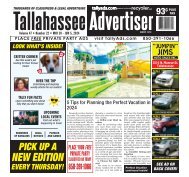You also want an ePaper? Increase the reach of your titles
YUMPU automatically turns print PDFs into web optimized ePapers that Google loves.
SAFETY<br />
TIPS<br />
cargo or destination at truck stops or over the CB.<br />
Be wary of anyone who asks what you’re hauling<br />
or where you’re going. Thieves look for loads they<br />
can dispose of easily for high dollar. Some drivers<br />
routinely tell others they are hauling wastepaper or<br />
some other unappealing product.<br />
If someone seems too interested in your load, alert<br />
your carrier — or even the local police. Once on the<br />
road, be alert for vehicles following you or people<br />
you see repeatedly.<br />
Everyone knows that there is a critical shortage<br />
of truck parking in some areas, and it’s difficult to<br />
be selective when there are few spaces available.<br />
Use your knowledge to help solve the problem. Find<br />
a space that is well lit at night and that’s not too<br />
secluded. When choosing a parking spot, consider<br />
whether you’ll be walking to the C-store or other<br />
business. A great parking space won’t help if you’ll<br />
have a long walk through dark areas.<br />
Sometimes, the location of a truck stop itself is a<br />
reason to bypass it. It might be better to stop a little<br />
earlier than to stay overnight at a truck stop in a<br />
high-crime area.<br />
When you prepare to get out of the truck, consider<br />
your wardrobe. Wear shoes and clothing that allow<br />
you to move quickly. Hooded garments can obstruct<br />
your vision, and flip-flops make running difficult, if it<br />
should come to that.<br />
Before you exit your truck, carefully check the<br />
area. Anyone you see should be either going into the<br />
truck stop or to their own truck. If you see someone<br />
lurking around your truck, notify truck-stop security,<br />
if they have it, or call the police.<br />
If the area is clear, lock your truck and walk<br />
quickly to your destination, continuously scanning<br />
the area for hazards, just like you do when driving.<br />
Not only will you identify problems more quickly,<br />
but you’ll also be letting potential criminals know<br />
you’re alert and catching you by surprise will be<br />
difficult.<br />
Some drivers carry some sort of defensive<br />
weapon when they are outside the truck. Mace and<br />
pepper spray are easy to obtain but are illegal in<br />
some areas. Knives can be turned and used against<br />
the victim. Other items, such as “tactical pens” or<br />
even a set of keys can be a weapon when used<br />
properly. Almost anything is better than nothing.<br />
One “weapon” that’s commonly mentioned is<br />
wasp and hornet spray. Designed for hard-to-reach<br />
targets like nests on a ceiling or in a tree, these<br />
products often spray a stream of 15 feet or more.<br />
The cans can be large and bulky to carry, however,<br />
and users have been sued due to the effects of the<br />
spray (the products are designed to kill pests, and<br />
not merely repel them).<br />
Then, there’s a weapon that isn’t a weapon at<br />
all — the “personal alarm.” These small, batteryoperated<br />
devices can emit a 130- to 140-decibel<br />
“scream” with the press of a button. Some devices<br />
include a small flashlight or flashing alert light.<br />
These devices are intended to discourage an<br />
attacker rather than be used as a defense, since<br />
no criminal wants the attention the alarm attracts.<br />
To be effective, however, the device must be within<br />
easy reach when you need it. Personal alarms<br />
are widely available at many stores, including<br />
C-stores at truck stops.<br />
Once back in the truck, be sure to lock the doors,<br />
of course. Since thieves have access to master keys<br />
and lock-defeating devices, however, many drivers<br />
employ a strap device that secures the doors to one<br />
another, adding an extra layer of security.<br />
A dog can provide protection if someone tries to<br />
enter the truck, and even a small dog can provide<br />
a warning if an intruder comes snooping. The<br />
downside, however, is that dogs need to be walked,<br />
resulting in the driver spending more time outside<br />
of the truck when stopped.<br />
When it comes to personal protection, every driver<br />
has to make their own decision. Some operate in<br />
areas that don’t present much risk, while others<br />
often travel to areas that are higher in crime.<br />
Sometimes it’s a matter of personal comfort and<br />
confidence. No matter the defensive choice,<br />
you’ll reduce the chances of needing to use it by<br />
remaining alert and planning for safety.<br />
12 TRUCKER’S CONNECTION www.TruckersConnection.com

















